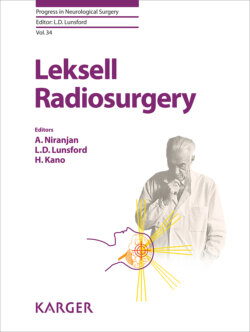Читать книгу Leksell Radiosurgery - Группа авторов - Страница 38
На сайте Литреса книга снята с продажи.
Abstract
ОглавлениеFor more than 65 years localization of brain targets suitable for stereotactic radiosurgery has been performed after application of an intracranial guiding device to the cranial vault. After imaging and dose planning the same frame is used to secure the target at the focus of the intersection of the ionizing radiation beams that create the radiobiological effect. Non-invasive immobilization systems first proposed for linear accelerator or proton radiation technologies have now been developed for the Leksell Gamma Knife ICON radiosurgical system. The ICON technology adds a cone-beam computed tomography (CBCT) scan to the original Perfexion radiosurgical device in order to define the brain stereotactic space. Marketed since 2015, the ICON can be used for standard radiosurgical procedures, most of which remain frame based, but also coupled with a non-invasive thermoplastic mask for carefully selected patients who undergo standard single-session radiosurgical procedures, as well as multisession procedures using repeat mask fixation. Both at UPMC as well as worldwide, mask immobilization has to date been used for approximately 10% of patients with specific characteristics: relatively simple dose plans, short radiation delivery times, and non-anxious patients, most of whom have metastatic or primary brain cancers. In certain cases, multisession radiosurgery is also performed using the mask. The workflow of frame versus frameless procedures is often altered, and is reliant on high-definition imaging, mostly MRI, done prior to dose planning. Since each CBCT takes 10–12 min to set up and acquire, co-register, and review with the treatment plan, and two CBCT scans are necessary to initiate the treatment plan, this workflow must be added to the beam on time. Although frame-based immobilization remains the predominant method to secure target fixation for problems suitable for single-session radiosurgery, the advent of a mask immobilization technique has proven valuable for a select group of patients. It also provides a non-invasive method to perform multisession or fractionated radiation in patients for whom traditional single-session radiosurgery is not feasible.
© 2019 S. Karger AG, Basel
Since the field of stereotactic radiosurgery (SRS) was first described by Lars Leksell in 1951, more than 1 million patients have undergone single-session Leksell radiosurgery using the initial prototype units, then the Gamma Knife U, B, C, 4C, and more recently the Elekta Perfexion® and ICON® technologies. Pushed by the competition which had developed non-invasive mask fixation systems for multisession SRS or fractionated radiation therapy, Elekta decided to modify the revolutionary Perfexion system to add mask-based immobilization of the patient’s head and to define stereotactic space using cone-beam computed tomography (CBCT). This ICON device can be used with both immobilization systems and has added a new dimension to the role of SRS and in some cases hypofractionated stereotactic radiation.
At UPMC we introduced ICON in 2016. In addition to our clinical patient care, our site has continued to be an international training site for SRS using the latest generation in Elekta technologies, currently Perfexion and ICON. After more than 15,000 clinical SRS cases as well as more than 122 training courses attended by more than 2,500 physicians, physicists, and nurses, UPMC has evaluated the role of each new generation SRS technology used in Leksell radiosurgery. This report describes the ICON modification as well as its current role. Worldwide, frame fixation continues to be used in more than 90% of brain stereotactic cases thought appropriate for SRS. Frameless mask fixation has been used in the remaining 10%, primarily in patients with malignant brain disease. The ideal patient has a relatively simple geometric brain radiosurgery target, is extraordinarily composed and relaxed, and can have the radiosurgical dose delivered in less than 30 min beam on time. At our institution the median beam on time was 22 ± 12 min for the first 90 mask-based treatments.
